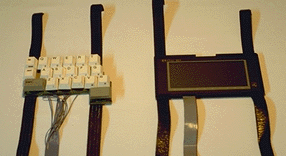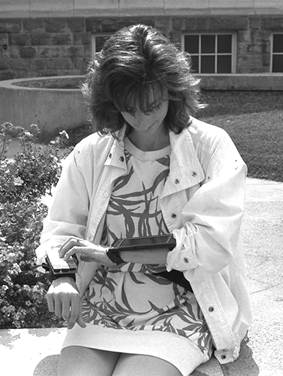Matias, E., MacKenzie, I. S., & Buxton, W. (1996). A wearable computer
for use in microgravity space and other non-desktop environments. Companion
of the CHI '96 Conference on Human Factors in Computing Systems. 69-70.
A Wearable Computer for Use in Microgravity Space
and Other Non-Desktop Environments
Edgar Matias
The Matias Corporation
178 Thistledown Boulevard
Rexdale, Ontario, Canada M9V 1K1
(416) 749-3124
ematias@dgp.toronto.edu
I. Scott MacKenzie
Dept. of Computing and Information Science
University of Guelph
Guelph, Ontario, Canada N1G 2W1
(519) 824-4120
mac@snowhite.cis.uoguelph.ca
William
Buxton
University of Toronto & Xerox PARC
c/o Computer Systems Research Institute
University of Toronto
Toronto, Ontario, Canada M5S 1A4
(416) 978-1961
buxton@dgp.toronto.edu
ABSTRACT
We present one possible design for a "wearable" computer--a computer that
is worn. Our prototype permits text entry without the need of a table or
other supporting surface. Typing can be performed while standing or even
walking. Possible applications for this device are also discussed.
KEYWORDS:
Input devices, input tasks, wearable computers, portable computers, Half-QWERTY,
one-handed keyboard, skill transfer.
INTRODUCTION
The tremendous and increasing popularity of notebook computers over the
past several years has encouraged manufacturers to push the envelope ever
further. This has led to the development of palmtops and PDAs, devices
small enough to fit in the palm of your hand. In an interesting spin-off,
the technologies which make these devices possible are being used to push
portability even further, creating a new breed of computer known as a "wearable."
While not yet common, their eventual success relies on finding niche applications
to pave the way for more general use. In this paper we present one possible
design for a wearable, and explore a few possible niches.
DESIGN PROTOTYPE
Our prototype wearable consists of three modules (Figure
1): keyboard [1],
display, and computer. The keyboard and display modules are strapped to
the operator's forearms. The computer module can be carried in a waist
pouch or backpack, along with batteries for power. By assuming the typing
posture in Figure 2, the operator can enter text
information. At other times, the operator's hands are free to perform other
tasks. In mobile applications, this is often important.

Figure 1. Keyboard and display modules of prototype wearable
computer. The computer and battery module is not shown.
Design Factors
We had four main goals in mind while designing our wearable:
-
Minimize training
-
Minimize fatigue
-
Minimize weight
-
Minimize power consumption
Training was minimized by using a Half-QWERTY one-handed keyboard as the
primary input device. This keyboard allows touch-typists to type one-handed
using their existing typing skills [1].
To minimize fatigue, we balanced the weight distribution of the device.
The keyboard (170 g) and display (175 g) modules are roughly the same weight,
and are light enough to avoid undue fatigue on the arms. The heavier batteries
and computer module (180 g) are worn on the waist or in a backpack, where
their weight is less fatigue inducing.
Much as with normal computer use, posture plays an important part in
minimizing the fatigue of using a wearable. Proper typing posture is shown
in Figure 2. The operator's arms rest against the
body, with the shoulders relaxed. The elbows are bent at 90 degree angles,
and the wrists are kept straight. This posture can be maintained for the
short time periods typical of most mobile text entry tasks. When not performing
such tasks, the operator's arms can rest at their sides.

Figure 2. Wearable worn by an operator. Proper typing
posture is shown. Operator's arms rest against the body, with shoulders
relaxed. Elbows are bent at 90 degree angles, and wrists are kept straight.
We minimized weight and power consumption by building our prototype
out of a palmtop computer. It weighed 325 g, before we started our modifications.
The final wearable (including belt pouch) weighs 655 g. It runs on two
AA batteries and uses various means of conserving power. For example, instead
of using a backlit grey-scale LCD, it uses a monochrome (1-bit) non-backlit
LCD and relies on ambient light. The result is a clear display with minimal
power consumption.
APPLICATIONS & ENVIRONMENTAL CONSTRAINTS
The environment in which a wearable is to be used places certain constraints
on its design, operation, and application. As a starting point, the following
four facilities, normally taken for granted in an office environment, are
not generally supplied by the environments in which wearable computers
are useful:
-
No desk
-
Gravity not as useful
-
No communications link
-
No power
Below we consider possible applications of wearables in two environments,
given the constraints listed above:
In-Shuttle Microgravity Space
In space, gravity is so weak that anything you push against projects you
away from it. This makes typing understandably difficult. It also makes
it an ideal environment for using a wearable computer. Since nothing external
is being pushed against, the "flying typist" problem is avoided. Astronauts
working inside a spacecraft could wear the units and use them for entering
and retrieving data. A wireless link could be established between the wearable
and the spacecraft's main computer, permitting the exchange and storage
of information.
Earth-Bound Non-Desktop Environments
A wearable is also well suited to work "in the field." This includes data
collection and retrieval in out-of-doors situations, such as: field service,
inventory, surveying, etc. As well, highly mobile in-door work can also
benefit from having a wearable. For example, inspectors performing on-site
evaluations of factories can take notes and call-up information on past
evaluations. When not entering information, their hands are still free
to point at things, grasp objects, make hand gestures, etc.
Operator Capacities
The environment can also limit or enhance an operator's capacity to perform
certain general functions. They include:
-
Holding capacity
-
Manipulation capacity
-
Carry/storage capacity
-
Rest capacity
For example, in space an operator's holding capacity is enhanced due to
the lack of gravity. A tool released in mid-air will remain suspended until
it is needed again. Such feats are not possible on Earth. These capacities
will also affect the net usability of wearables.
REFERENCES
[1]Matias, E., MacKenzie,
I. S., & Buxton, W. (1994). Half-QWERTY: Typing
with one hand using your two-handed skills. Companion of the CHI
'94 Conference on Human Factors in Computing Systems (pp. 51-52). New
York: ACM. .


